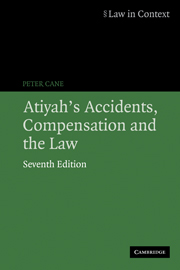Book contents
- Frontmatter
- Contents
- Preface
- List of abbreviations
- List of tables
- Table of legislation
- Table of cases
- Part One The Issues in Perspective
- Part Two The Tort System in Theory
- 2 Fault as a basis of liability
- 3 The scope of the tort of negligence
- 4 Departures from the fault principle
- 5 Causation and remoteness of damage
- 6 Damages for personal injury and death
- 7 An appraisal of the fault principle
- Part Three The Tort System in Operation
- Part Four Other Compensation Systems
- Part Five The Overall Picture
- Part Six The Future
- Index
2 - Fault as a basis of liability
Published online by Cambridge University Press: 05 June 2012
- Frontmatter
- Contents
- Preface
- List of abbreviations
- List of tables
- Table of legislation
- Table of cases
- Part One The Issues in Perspective
- Part Two The Tort System in Theory
- 2 Fault as a basis of liability
- 3 The scope of the tort of negligence
- 4 Departures from the fault principle
- 5 Causation and remoteness of damage
- 6 Damages for personal injury and death
- 7 An appraisal of the fault principle
- Part Three The Tort System in Operation
- Part Four Other Compensation Systems
- Part Five The Overall Picture
- Part Six The Future
- Index
Summary
The conceptual basis of tort law
The aim of this Part is to explain the main features of tort law as a system for compensating for personal injuries and death, and to examine its main theoretical defects as a compensation mechanism. We will focus on tort law because most claims for damages for personal injuries and death are ‘made in’ tort; although occasionally such a claim may be ‘made in’ contract or based on some statutory cause of action. The boundaries of a legal subject are not set by divine prescript but by the custom of lawyers. Tort law as a separate legal subject is largely a product of the systematizing activities of academic lawyers in the nineteenth century. This body of law deals with a variety of social and economic problems that may be classified in a number of different ways, for instance, by looking at the interest of the person who complains of some injury: are they complaining about deprivation of liberty; injury to their person or feelings; damage to property, or the invasion of land; damage to reputation or invasion of privacy; injury to relations between members of a family; damage to trade or business? Alternatively, problems may be looked at in terms of the cause of the injury: who caused it; was it caused intentionally, maliciously, negligently or without ‘fault’ on the part of anyone; did the injured person play a part in causing the injuries?
A third way of classifying problems is according to the relationship between the claimant and the defendant.
- Type
- Chapter
- Information
- Atiyah's Accidents, Compensation and the Law , pp. 33 - 67Publisher: Cambridge University PressPrint publication year: 2006

